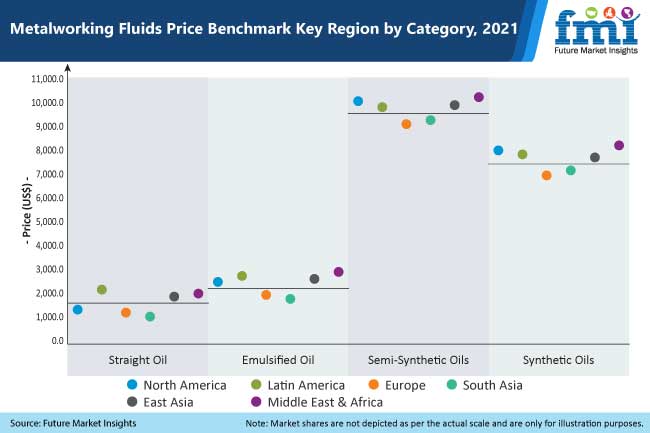As per a latest market study by Future Market Insights (FMI), the demand for metalworking fluids is projected to grow at 3.7% CAGR between 2021 and 2031, reaching US$ 9.61 Bn in 2021. With a favorable demand outlook, sales of metalworking fluids are poised to total 36,67,557.1 Tons by 2031. Increasing adoption of metalworking fluids for the production of key metal components in the transportation equipment and heavy machinery industries will continue augmenting market growth. Growing preference for lightweight metals such as aluminum, copper, and zinc in production of complex components used in high performance applications is anticipated to boost sales of metalworking fluids over the forecast period.
Request FREE PDF Brochure This Report: https://www.futuremarketinsights.com/reports/brochure/rep-gb-517
Rapid urbanization and population growth are leading to a surge in demand for private transportation vehicle and increased spending on public transport. The automotive industry has been a key beneficiary of this trend, as automotive sales continued increasing in developing countries such as China, India, Saudi Arabia, and ASEAN nations.
Similar growth has been recorded in these markets for public transportation facilities such as metro trains, resulting in high demand for metalworking fluids in the automotive and transportation sectors. However, various stringent regulations regarding the usage of harmful synthetic chemicals are restricting the market growth. To counter this issue, manufacturers are investing in research and development activities to develop eco-friendly lubrication solutions.
Emergence of bio-based fluids, and other multifunctional fluids to reduce incompatibility will continue providing tailwinds to metalworking fluids sales in the forthcoming years.
Key Takeaways from Metalworking Fluids Market Study
- Transportation equipment is the leading consumer of metalworking fluids, accounting for and more than half of the overall metalworking fluids produced.
- Sales of straight oils are projected to increase by 3.1% year-over-year in 2021.
- Based on product type, sales of metal removal fluids are projected to command over 50% of the total metalworking fluids market share.
- The U.S. will continue dominating the North America metalworking fluids market, growing by 3.0% year-over-year rate in 2021.
- Demand for metalworking fluids in Germany is anticipated to rise at a 3.5% CAGR through 2031.
- China will emerge as a lucrative metalworking fluids market, expanding at a 5.1% CAGR over the forecast period.
- Japan and South Korea will collectively account for 9.7% of the total metalworking fluids market share.
Request a Complete TOC of this Report with figures: https://www.futuremarketinsights.com/toc/rep-gb-517
“Increasing sales of lightweight automotive such as electronic vehicles (EVs), along with innovations in fluid blends to cater to diverse industrial requirements will continue pushing the sales of metalworking fluids over the forecast period,” says the FMI analyst.
Metalworking Fluids Market: Participant Insights
Key players operating in the global metalworking fluids market comprise ExxonMobil Corporation, Idemitsu Kosan Co. Ltd., Quaker Chemical Corporation, FUCHS Petrolub SE, Total Energies SE, Apar Industries Limited, Yushiro Chemical Industry Co. Ltd., Cimcool Industrial Products LLC, and Metalworking Lubricants Company.
As per FMI’s analysis, top 5 players including Quaker Chemical Corporation, ExxonMobil Corporation, Total Energies SE, Idemitsu Kosan Co. Ltd. and BP plc. are projected to account for 45-55% of the total metalworking fluid market share.
In efforts to gain a competitive edge, leading players are focusing on research and development to launch new and innovative products that are more efficient and comply with various stringent regulations. In addition to this, collaborations, mergers, and acquisitions will remain effective growth strategies among players over the assessment period. For instance:
- In 2021, Quaker Chemical Corporation announced the beginning of a new joint venture with Grindaix GmbH, which is a German provider of high-tech coolant control solutions and delivery systems.
- In 2021, Idemitsu and IHI Corporation announced that they had concluded a joint agreement to establish a supply chain network for ammonia.
Metalworking Fluids Market by Category
By Category:
- Straight Oil
- Emulsified Oil
- Semi-Synthetic oils
- Synthetic Oils
By Product Type:
- Removal Fluid
- Protection Fluids
- Forming Fluids
- Treating Fluids
By End-Use:
- Metal Fabrication
- Heavy Machinery
- Transportation Equipment
- General Manufacturing
More Insights into the Metalworking Fluids Market Report
In its latest report, FMI offers an unbiased analysis of the global metalworking fluids market, providing historical data for the period of 2016-2020 and forecast statistics for the period of 2021-2031. In order to understand the global market potential, its growth, and scope, the market is segmented on the basis of category (straight oil, emulsified oil, semi-synthetic oil, and synthetic oil), product type (removal fluid, protection fluids, forming fluids, and treating fluids) end-use type (metal fabrication, heavy machinery, transportation equipment, and general manufacturing) and across seven regions (North America, Latin America, Eastern Europe, Western Europe, Asia Pacific excluding Japan (APEJ), Japan, and Middle East & Africa).
Ask us your Any Queries About this Report: https://www.futuremarketinsights.com/askus/rep-gb-517
The Chemicals & Materials division at FMI offers distinct and pin-point analysis about the chemicals & materials industry. Coverage of the chemicals and materials market extends from commodity, bulk, specialty and petrochemicals to advanced materials, composites, and nanotechnology. The team also puts special emphasis on ‘green alternatives’, recycling and renewable technology developments, and supply-demand trade assessment. Our research studies are widely referred by chemical manufacturers, research institutions, channel partners, and government bodies for developing – ‘The Way Forward’.

